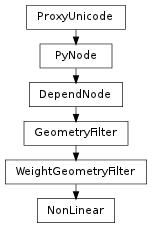pymel.core.nodetypes.NonLinear¶

- class NonLinear(*args, **kwargs)¶
class counterpart of mel function nonLinear
This command creates a functional deformer of the specified type that will deform the selected objects. The deformer consists of three nodes: The deformer driver that gets connected to the history of the selected objects, the deformer handle transform that controls position and orientation of the axis of the deformation and the deformer handle that maintains the deformation parameters. The type of the deformer handle shape created depends on the specified type of the deformer. The deformer handle will be positioned at the center of the selected objects’ bounding box and oriented to match the orientation of the leading object in the selection list. The deformer handle transform will be selected when the command is completed. The nonLinear command has some flags which are specific to the nonLinear type specified with the -type flag. The flags correspond to the primary keyable attributes related to the specific type of nonLinear node. For example, if the type is “bend”, then the flags “-curvature”, “-lowBound” and “-highBound” may be used to initialize, edit or query those attribute values on the bend node. Examples of this are covered in the example section below.
- after(val=True, **kwargs)¶
If the default behavior for insertion/appending into/onto the existing chain is not what you want then you can use this flag to force the command to stick the deformer node after the selected node in the chain even if a new geometry shape has to be created in order to do so. Works in create mode (and edit mode if the deformer has no geometry added yet).
Derived from mel command maya.cmds.nonLinear
- afterReference(val=True, **kwargs)¶
The -afterReference flag is used to specify deformer ordering in a hybrid way that choses between -before and -after automatically. If the geometry being deformed is referenced then -after mode is used in adding the new deformer otherwise -before mode is used. The net effect when using -afterReference to build deformer chains is that internal shape nodes in the deformer chain will only appear at reference file boundaries, leading to lightweight deformer networks that may be more amicable to reference swapping.
Derived from mel command maya.cmds.nonLinear
- before(val=True, **kwargs)¶
If the default behavior for insertion/appending into/onto the existing chain is not what you want then you can use this flag to force the command to stick the deformer node before the selected node in the chain even if a new geometry shape has to be created in order to do so. Works in create mode (and edit mode if the deformer has no geometry added yet).
Derived from mel command maya.cmds.nonLinear
- frontOfChain(val=True, **kwargs)¶
This command is used to specify that the new deformer node should be placed ahead (upstream) of existing deformer and skin nodes in the shape’s history (but not ahead of existing tweak nodes). The input to the deformer will be the upstream shape rather than the visible downstream shape, so the behavior of this flag is the most intuitive if the downstream deformers are in their reset (hasNoEffect) position when the new deformer is added. Works in create mode (and edit mode if the deformer has no geometry added yet).
Derived from mel command maya.cmds.nonLinear
- getDeformerTools(**kwargs)¶
Returns the name of the deformer tool objects (if any) as string string ...
Derived from mel command maya.cmds.nonLinear
- getExclusive(**kwargs)¶
Puts the deformation set in a deform partition.
Derived from mel command maya.cmds.nonLinear
- getGeometry(**kwargs)¶
The specified object will be added to the list of objects being deformed by this deformer object, unless the -rm flag is also specified. When queried, this flag returns string string string ...
Derived from mel command maya.cmds.nonLinear
- getGeometryIndices(**kwargs)¶
Complements the -geometry flag in query mode. Returns the multi index of each geometry.
Derived from mel command maya.cmds.nonLinear
- parallel(val=True, **kwargs)¶
Inserts the new deformer in a parallel chain to any existing deformers in the history of the object. A blendShape is inserted to blend the parallel results together. Works in create mode (and edit mode if the deformer has no geometry added yet).
Derived from mel command maya.cmds.nonLinear
- prune(val=True, **kwargs)¶
Removes any points not being deformed by the deformer in its current configuration from the deformer set.
Derived from mel command maya.cmds.nonLinear
- remove(val=True, **kwargs)¶
Specifies that objects listed after the -g flag should be removed from this deformer.
Derived from mel command maya.cmds.nonLinear
- setGeometry(val=True, **kwargs)¶
The specified object will be added to the list of objects being deformed by this deformer object, unless the -rm flag is also specified. When queried, this flag returns string string string ...
Derived from mel command maya.cmds.nonLinear